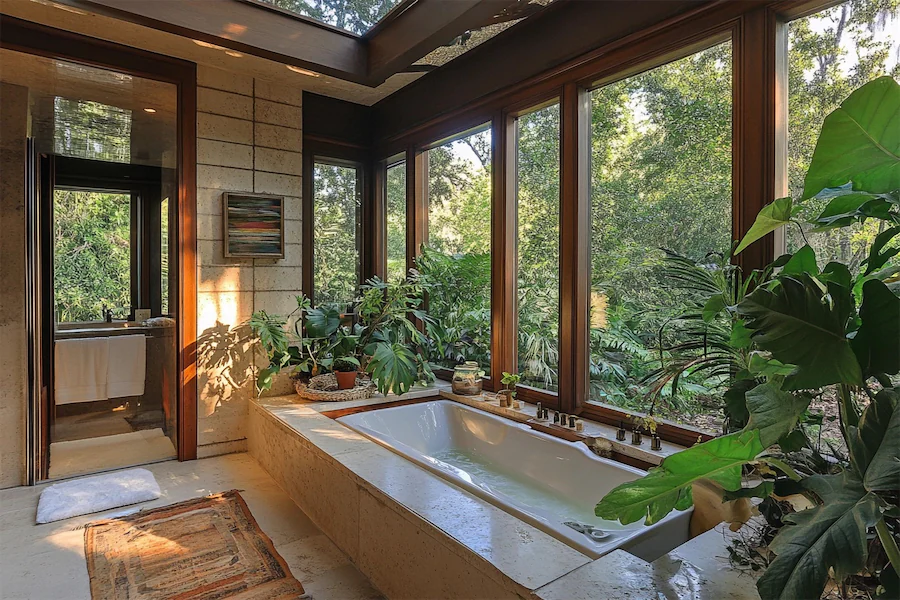Transforming your bathroom into an aromatherapy haven can significantly enhance relaxation and well-being. This article explores the history, key features, applications, considerations, and concludes with insights into aromatherapy bathrooms.
Introduction to Aromatherapy Bathrooms
Aromatherapy involves using natural plant extracts, particularly essential oils, to promote health and well-being through scent. Incorporating aromatherapy into bathroom design creates a spa-like atmosphere, turning daily routines into therapeutic experiences.
History and Origins of Aromatherapy Bathrooms
Aromatherapy has ancient roots, with civilizations like the Egyptians and Greeks utilizing aromatic oils for medicinal and ritualistic purposes. The integration of aromatherapy into modern bathroom design reflects a growing emphasis on wellness and self-care, aiming to create personal sanctuaries within the home.
Key Features of Aromatherapy Bathrooms
- Essential Oil Diffusers: Devices that disperse essential oils into the air, filling the bathroom with therapeutic scents. Options include ultrasonic diffusers, which use water and ultrasonic waves to create a fine mist, and nebulizing diffusers, which release pure essential oil particles without water.
- Scented Candles: Candles infused with essential oils provide both illumination and fragrance, enhancing the ambiance. For instance, lavender-scented candles can promote relaxation, while eucalyptus scents can invigorate the senses.
- Natural Materials: Incorporating elements like wood and stone can enhance the sensory experience, complementing the aromatic environment. Materials such as cedarwood or bamboo not only add a pleasant scent but also contribute to a calming aesthetic.
- Indoor Plants: Adding plants like eucalyptus or lavender introduces natural fragrances and contributes to a serene atmosphere. Hanging a bundle of fresh eucalyptus in the shower allows the steam to release its invigorating scent.
Applications of Aromatherapy in Bathrooms
- Stress Reduction: Scents like lavender and chamomile are known for their calming effects, making them ideal for evening relaxation routines. Incorporating these scents through diffusers or bath salts can help alleviate stress after a long day.
- Invigoration: Citrus or peppermint scents can energize and uplift, providing a refreshing start to the day. Using shower steamers infused with these essential oils can invigorate the senses during morning showers.
- Enhanced Aesthetics: Aromatherapy elements contribute to a spa-like ambiance, elevating the bathroom’s overall design. Incorporating scented candles, essential oil diffusers, or natural bath salts can infuse the air with soothing fragrances.
Considerations When Designing an Aromatherapy Bathroom
- Ventilation: Ensure proper ventilation to prevent overwhelming scents and maintain air quality. While aromatherapy can enhance relaxation, inadequate ventilation may lead to the accumulation of strong odors, potentially causing discomfort.
- Quality of Essential Oils: Use high-quality, pure essential oils to maximize therapeutic benefits and avoid synthetic additives. Pure essential oils are more potent and effective, providing genuine aromatherapy benefits.
- Safety Measures: Be mindful of potential allergies or sensitivities to certain scents; always test a small amount first. Additionally, ensure that candles are never left unattended, and diffusers are used according to manufacturer instructions to prevent accidents.
- Maintenance: Regularly clean diffusers and replace candles to maintain optimal performance and hygiene. Accumulation of residue in diffusers can hinder their functionality and may affect the quality of the dispersed aroma.
Conclusion
Incorporating aromatherapy into your bathroom design transforms the space into a personal retreat, promoting relaxation and well-being. By thoughtfully selecting scents and integrating natural elements, you can create a harmonious environment that enhances your daily routines.
